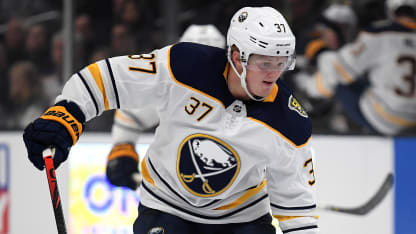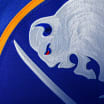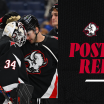It's the sort of comparison that can draw chirps from friends when you're a 20-year-old who's just two seasons removed from playing high school hockey. It was also a point of emphasis from Ralph Krueger and his coaching staff when the Sabres met Wednesday morning.
The play begins with Mittelstadt working to retrieve a puck behind his own net with a pair of Sharks surrounding him, one of which is six-time All-Star Erik Karlsson. Mittelstadt puts his head down and hustles up the ice as Karlsson emerges for a 2-on-1 rush, defended by Henri Jokiharju.
Jokiharju drops to the ice, stalling Karlsson just long enough for Mittelstadt to complete his pursuit. The second-year center intercepts Karlsson's crossing pass, carries the puck into the neutral zone, circles back to give his linemates a chance to change, then hits Rasmus Ristolainen with a pass at the far blue line, setting the Sabres free on a game-winning, odd-man rush.
"I kind of was wincing for him seeing that it was Karlsson because a lot of times you're not going to catch him," Sabres forward Jimmy Vesey said. "But he put his head down and got back. I think Henri played the 2-on-1 very well, bought Casey that one extra second for him to get back. He gets the puck and we win the game."
Mittelstadt downplayed the sequence.
"I saw Karlsson get the puck and they had a two-on-one," Mittelstadt said. "I pretty much had no choice but to go, I guess. I don't know, I don't think it's that big a deal. I think anyone on our team would've done it. I guess it's just something you got to do."
To Krueger, the idea that any member of the team would do the same thing is what made the play a big deal. Krueger cited the sequence as a microcosm of the dedication to playing without the puck that's made the Sabres so successful through their 8-1-1 start.
"It was the main point in the meeting today," Krueger said. "The tracking that he did from our end back to the front of our net in stealing that puck, then delaying in the neutral zone so they got baited into making a line change and then turning it up ice really quickly on that opportunity.
"It definitely didn't get lost, because pretty much everything that's happening here on the positive offensively - five-on-five, four-on-four or three-on-three - is coming out of excellent defensive work and decisions that guys are making. That gets lost in the general analysis of a game - what happens, the tracking, the way the D are gapping up, and all of that is causing the opposition stress in that we're attacking them when they're quite weak, and that's what happened there."



















